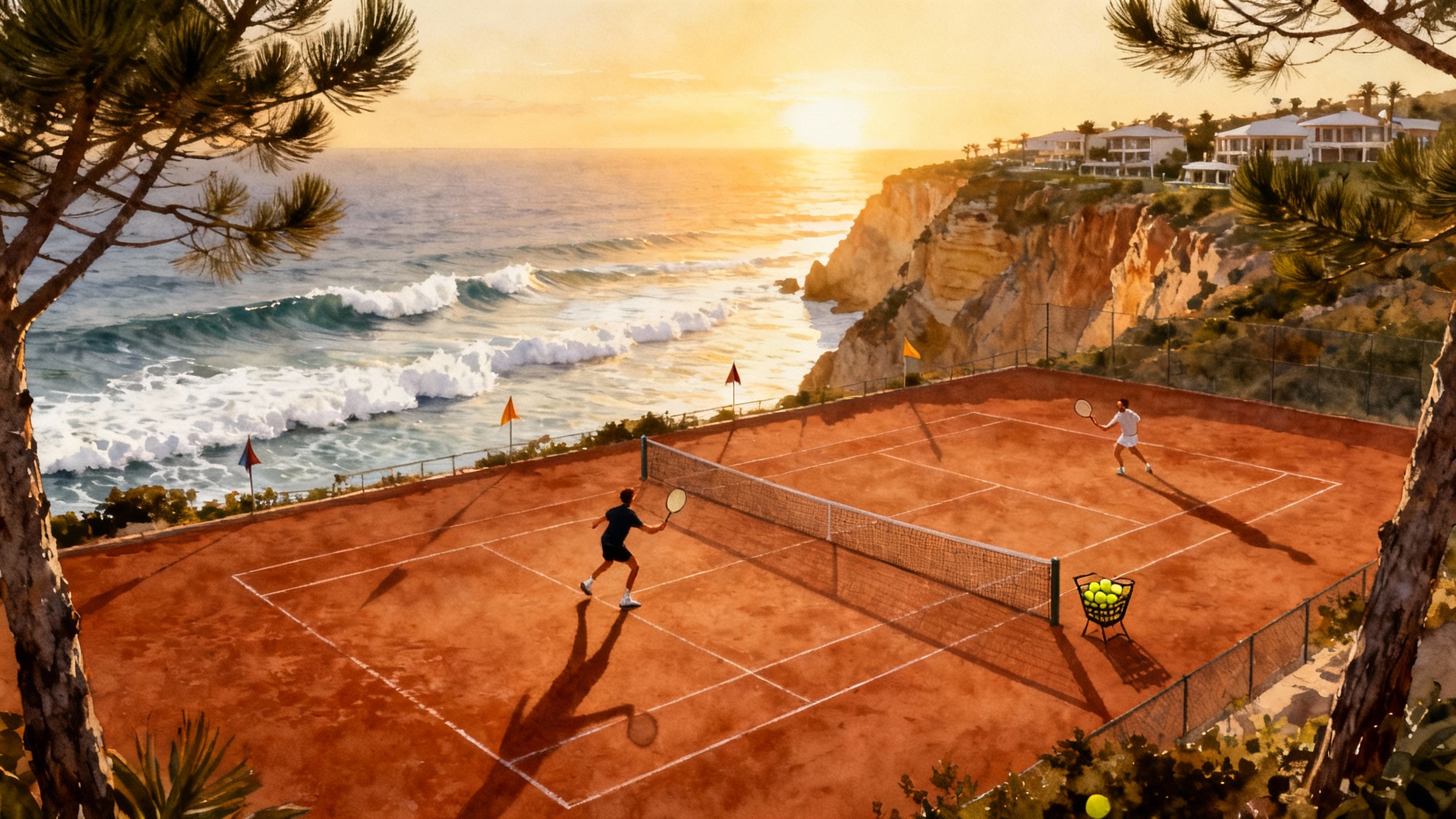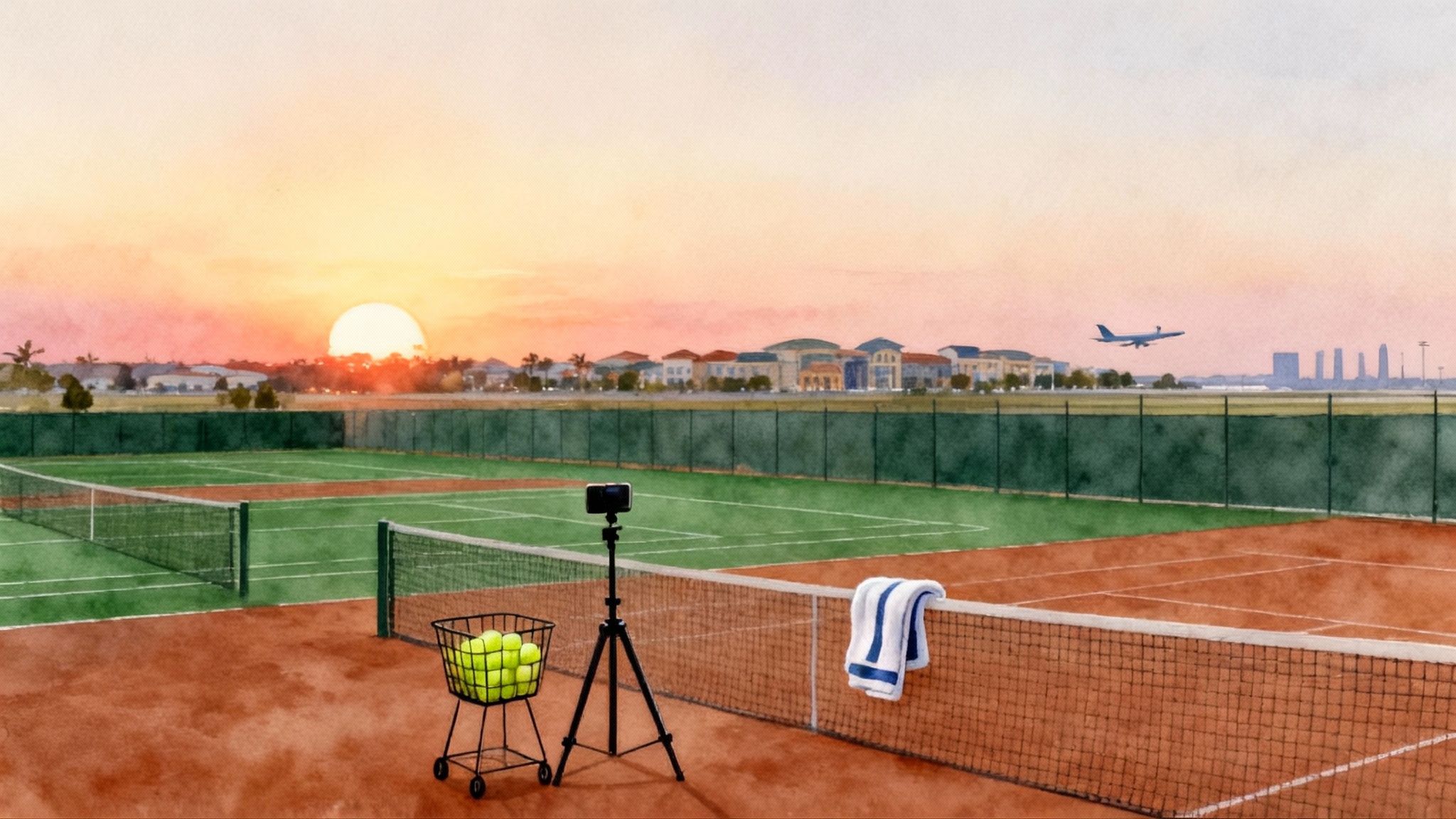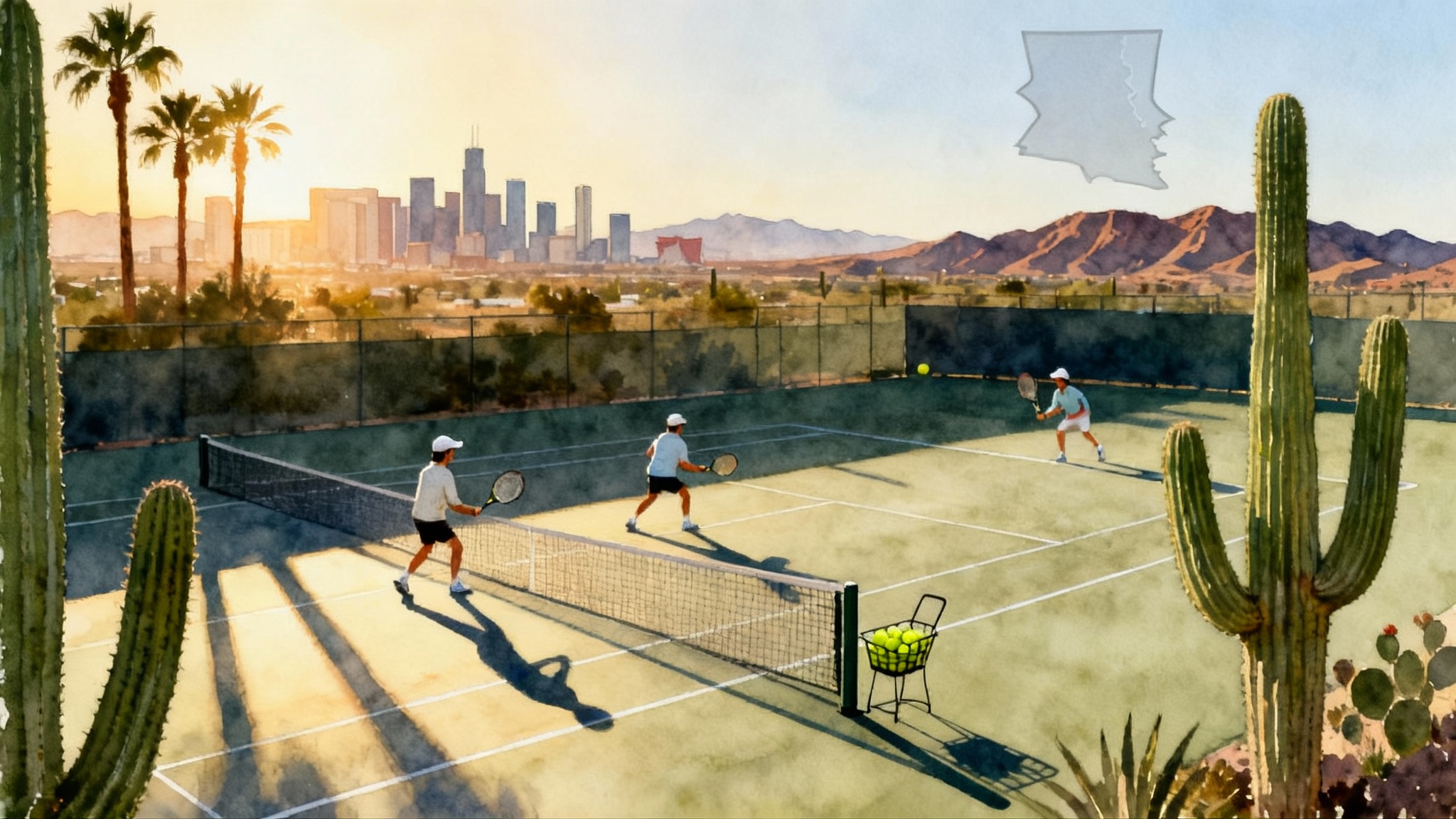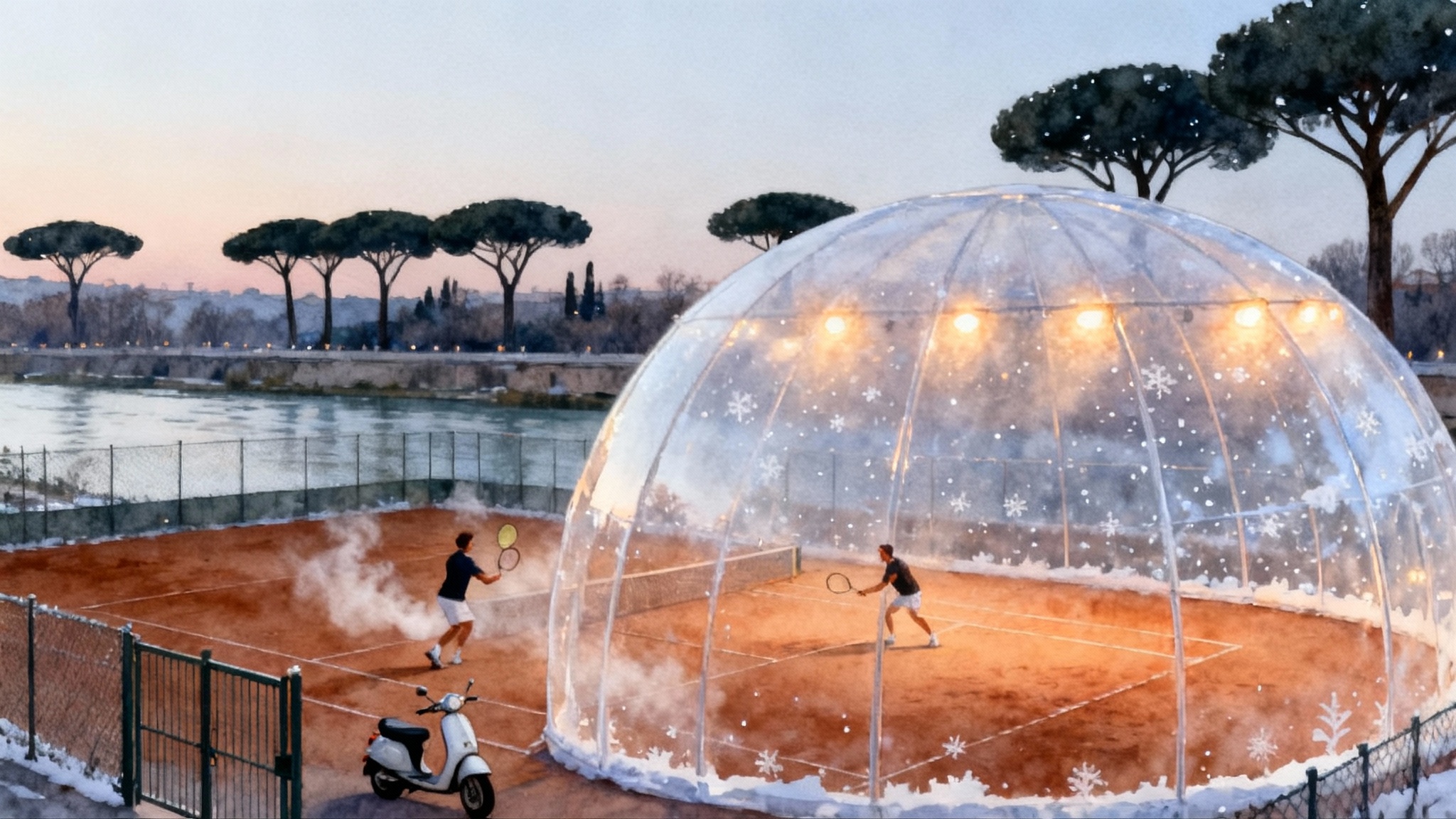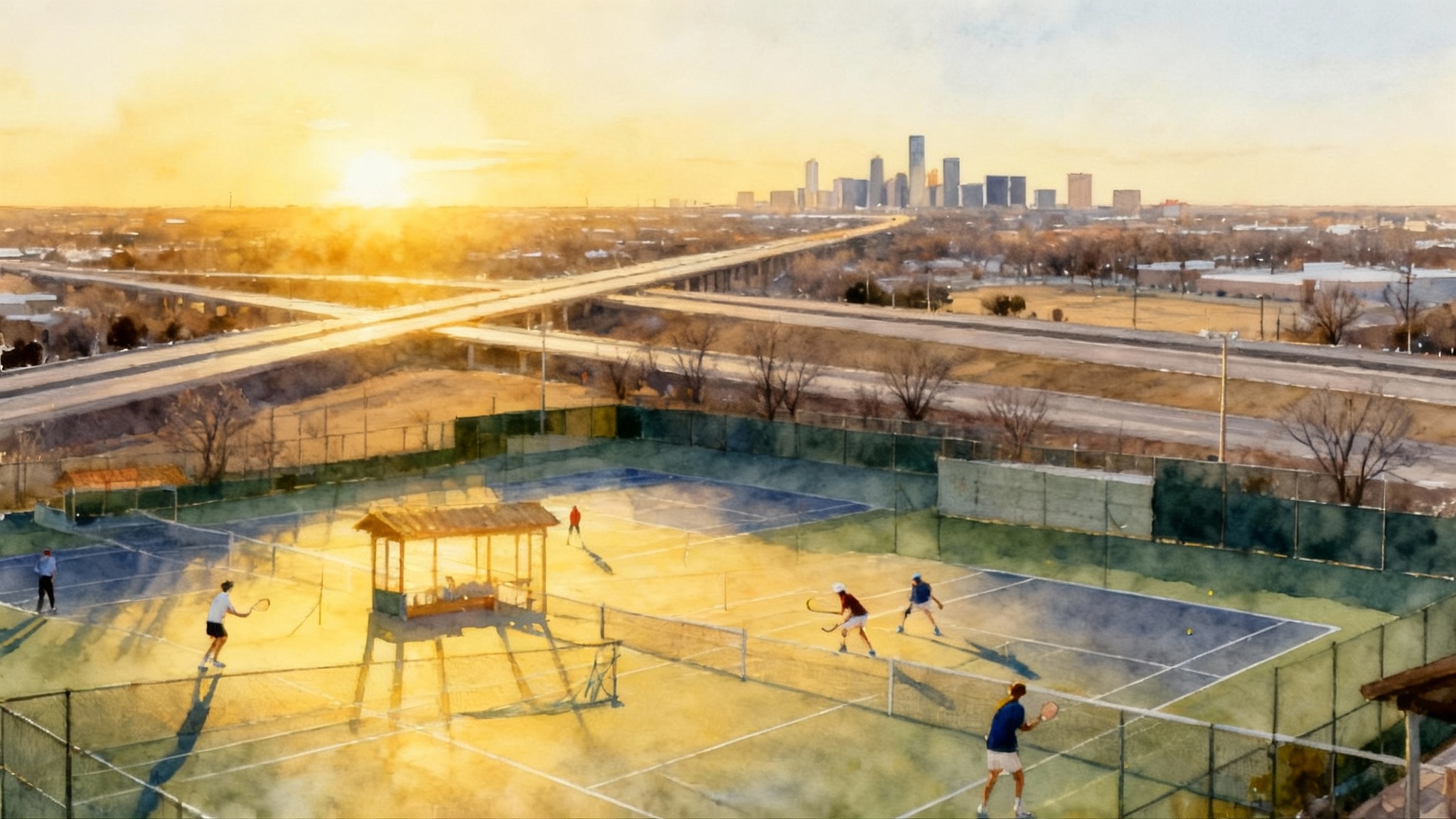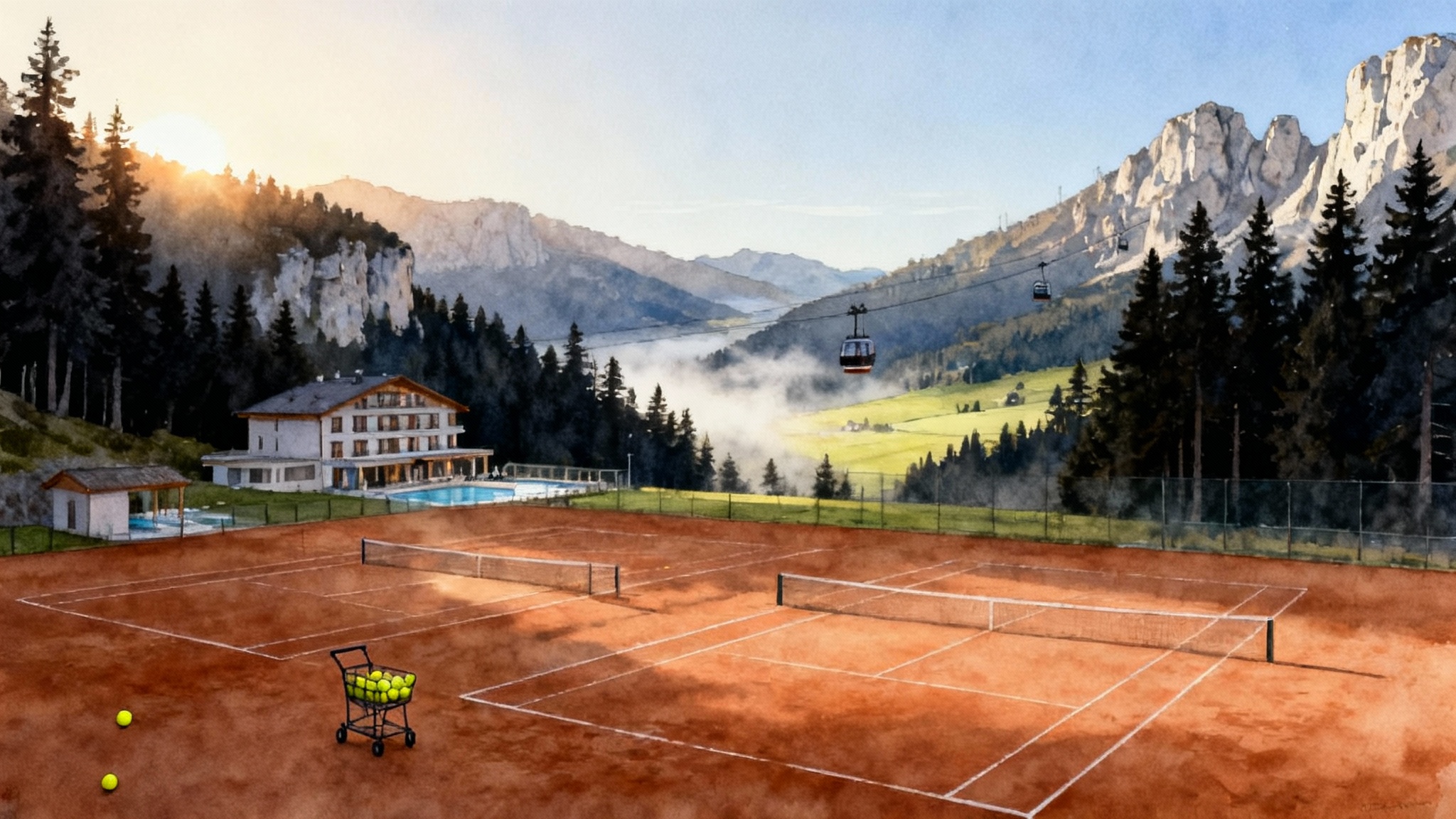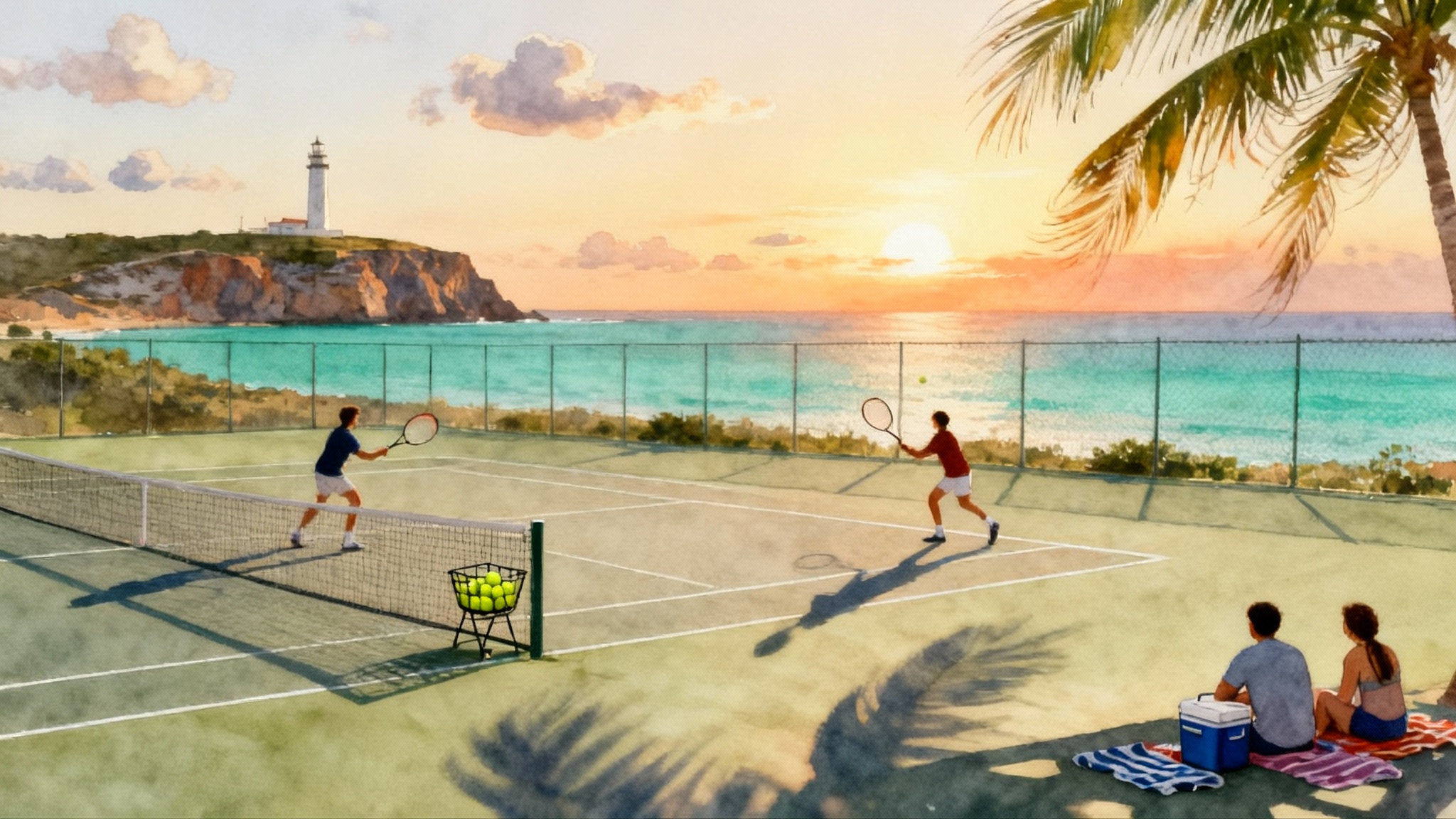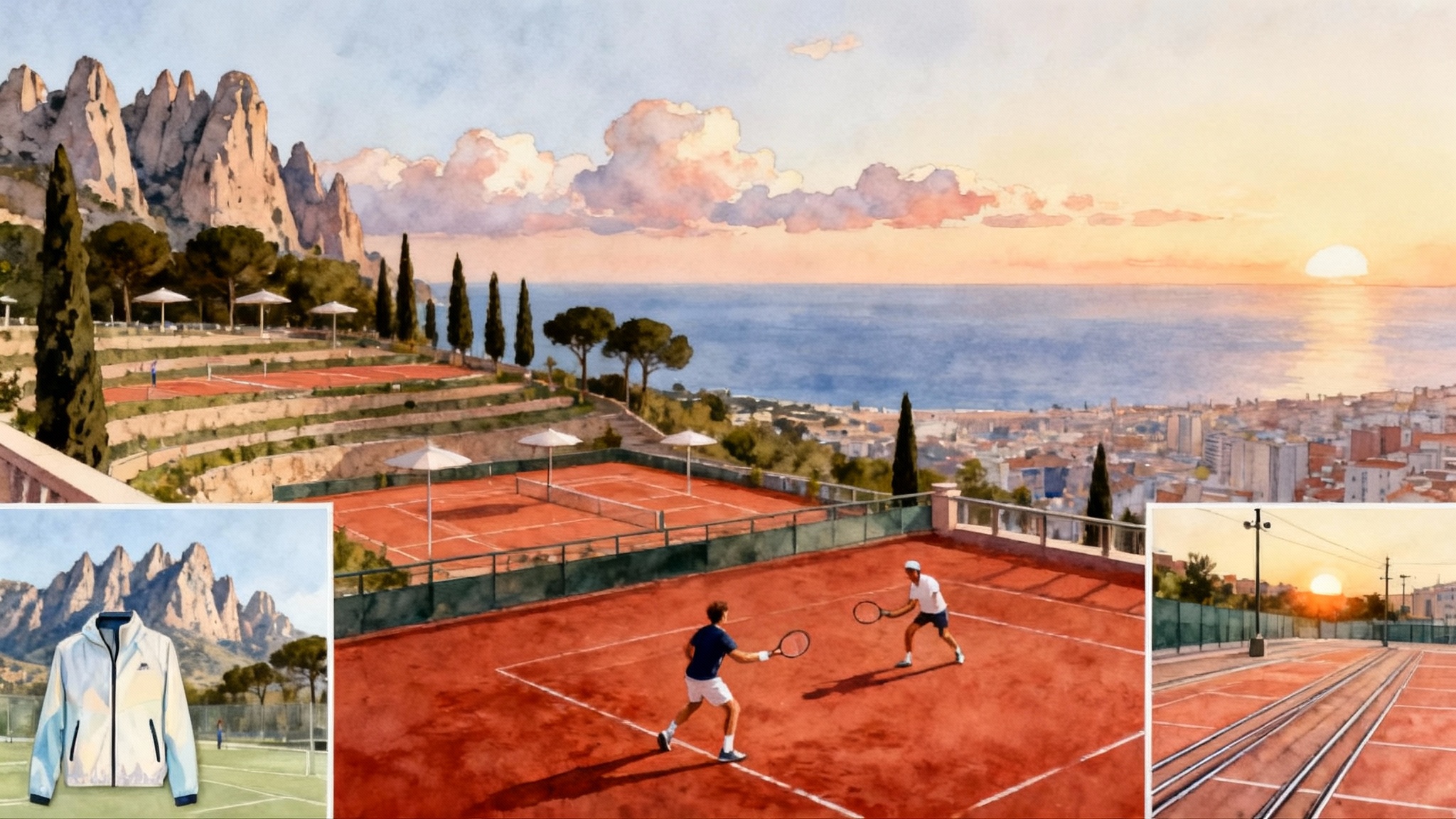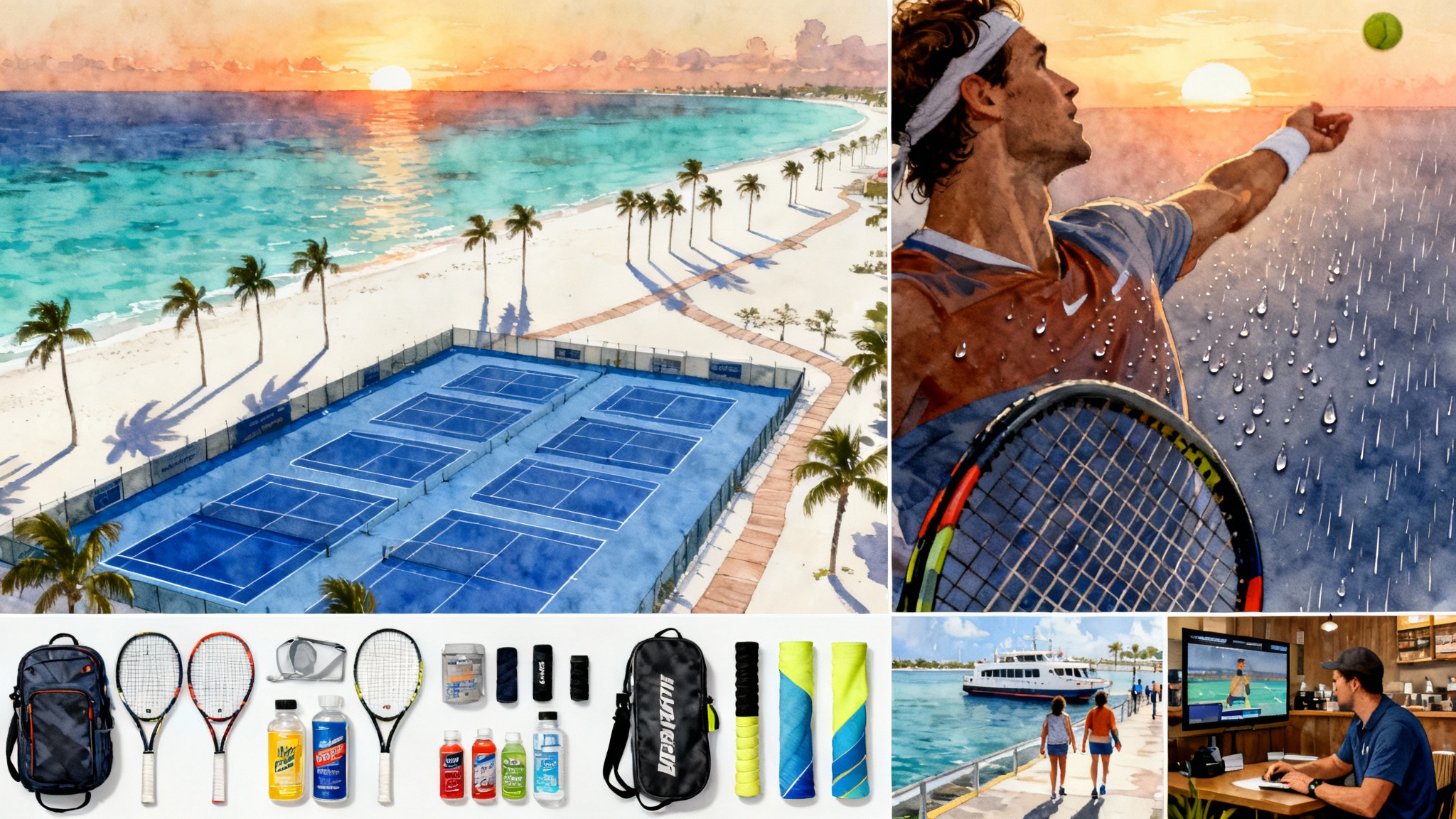Cyprus Winter Tennis 2025-26: Sun-Safe Training in Larnaca
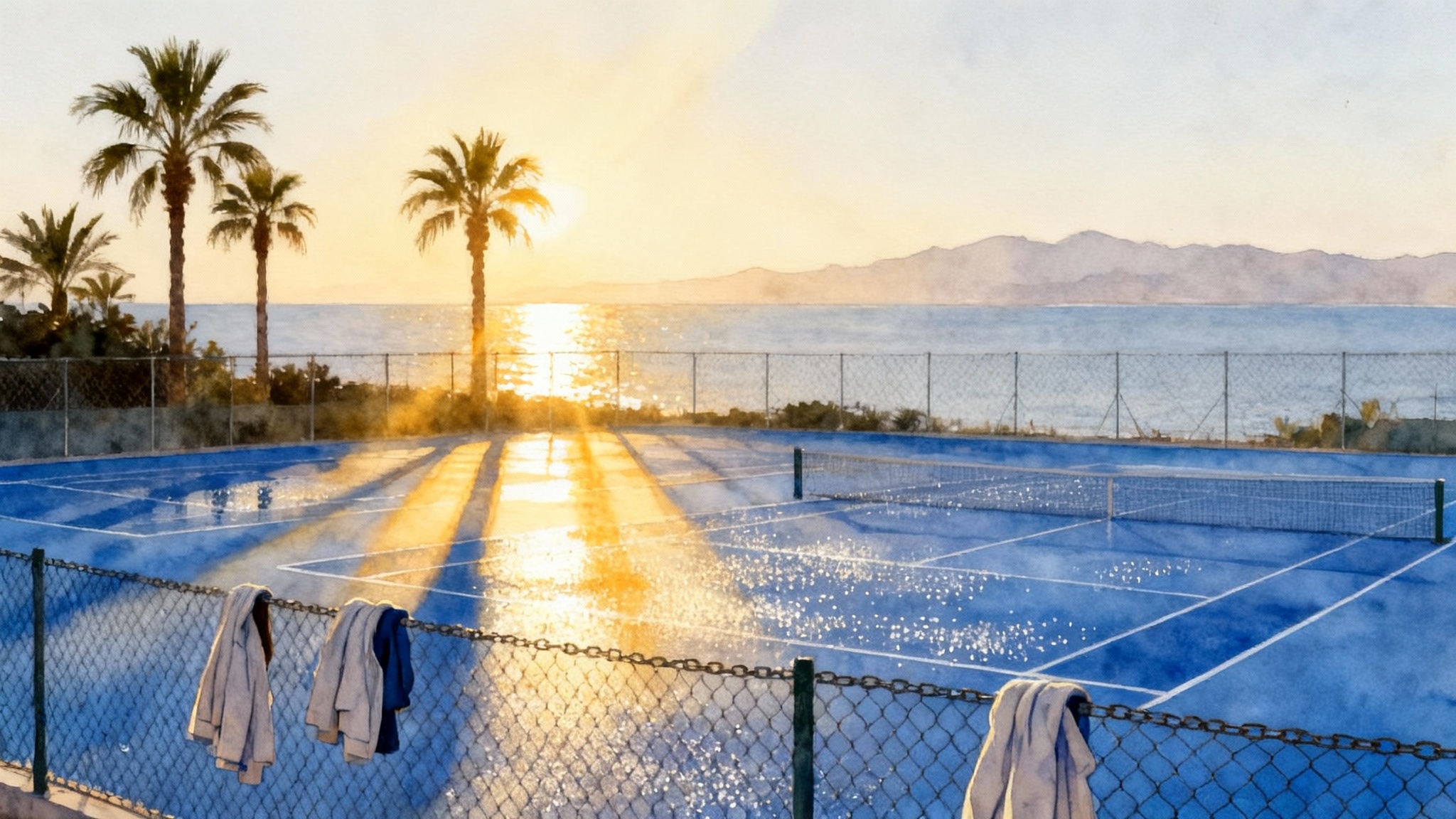
Why Larnaca for a winter hard-court block
If you want reliable outdoor tennis between November and March without long-haul heat or deep-winter gloom, Larnaca hits a rare sweet spot. Daytime highs often sit in the mid to high teens Celsius, which is the low 60s Fahrenheit, with plenty of bright hours and a moderate ultraviolet index. You can structure a sun-safe load of quality hard-court work, then step straight into the city’s flat promenades for easy recovery walks. Most days you will be outside in a light layer, not bundled up. That steadiness is why Larnaca works for a one to three week training block that actually builds your game instead of fighting the weather.
Deciding between bases in winter? Compare Mediterranean options in our guide to Tenerife vs Gran Canaria winter tennis and consider a clay-forward alternative with the Valencia climate-smart clay guide.
Herodotou Tennis Academy sits on the city side of the coastline, which means quick transitions between courts, apartment, and food. The courts are hard, the environment is friendly, and the airport is ten to fifteen minutes by car. This guide puts climate first, then drills down into schedules, surfaces, walkability, match play, travel logistics, and costs so you can book with confidence.
Climate primer: November to March
Think in weather windows, not fixed dates. In Larnaca from November through March you usually get a long run of playable days punctuated by short-lived fronts. Here is how the season typically feels on court:
- Temperature: most afternoons reach 15 to 20 degrees Celsius, which is 59 to 68 Fahrenheit. Evenings can drop to 9 to 12 Celsius, which is high 40s to low 50s Fahrenheit. Pack a light midlayer and a softshell for warm-ups.
- Sunlight: expect roughly ten hours of daylight in midwinter, a bit more in November and March. Low sun angles are kinder to skin and eyes, yet bright enough for ball tracking.
- Rain: winter is the wetter part of the year, but in Larnaca that usually means short showers or a few consecutive grey days rather than week-long washouts. Plan for one notably wet day most weeks in December and January, then build a cushion day into your schedule.
- Humidity: often moderate. Balls do not fluff as quickly as in damp Atlantic climates, so your hard-court pace stays consistent.
The takeaway is simple. Set your key volume and intensity blocks around the drier, sunnier stretches, and keep a flexible day to swap in case a front rolls through.
Wind and when to hit
Sea breeze patterns shape ball flight more than the thermometer. On most days the air is calmer early, then a breeze builds after late morning as land warms, before easing again close to sunset. Use that rhythm to your advantage:
- Early morning, 8:00 to 11:00: generally the calmest. Load technical work, serve accuracy, and pattern building here.
- Late morning to midafternoon: expect a light to moderate cross-breeze from the coast. This is the slot for footwork under pressure, high ball tolerance, and depth control into wind and with wind.
- Late afternoon, last ninety minutes of light: wind usually tapers. Shift to point play, return patterns, and competitive sets.
On breezier days, set the net strap a touch lower to reward driving trajectories, bring an extra set of balls, and commit to targets through the middle third until you have the measure of the gusts.
Your base: Herodotou Tennis Academy
Herodotou Tennis Academy is a hard-court environment with a simple advantage in winter: the surface plays true in cool, dry air, so your footwork and timing translate well when you return to spring events. Expect well-kept acrylic courts with lighting that allows an early start or a late finish, plus friendly staff who understand visiting players. Bring questions about stringing and ball machines in advance, since availability can vary by week, and consider arriving with a fresh restring if you play with a lively multifilament that loses tension faster in temperature swings.
Court-speed feel: in cool conditions, the ball stays a touch lower and skids a bit, which rewards early preparation and compact finishing. It is a great time to sharpen first-serve percentage, return depth, and backhand stability.
Court access and booking
- Lead time: in winter you can often book day to day, but the safest path is to secure your key morning blocks one to two weeks out, especially in holiday windows around late December and early January.
- Duration: reserve in ninety-minute units for drilling, two hours for match play. Build a ten-minute buffer between blocks for hydration and surface check.
- Lighting: budget for a small premium on lit evening sessions if you extend into dusk.
If you prefer a routine, block the same times across your stay. The body adapts quickly to predictable light and wind.
Walkable accommodation near courts
Larnaca is compact, and that is a big win for recovery. Look for apartments within a fifteen to twenty minute walk of the courts. A flat street grid means easy commutes by foot or by a simple city bike. Choose places with the following features:
- A quiet bedroom facing away from main roads, which helps sleep during the occasional breezy night.
- A kitchenette. Winter produce and local staples make self-catering both healthy and cost effective.
- A washing machine for training kit. Drying is quick in sunny conditions.
If you prefer the beach vibe, consider staying near the Mackenzie or Finikoudes promenade and cycling to the academy. Pack a lightweight front light for late returns. Drivers in Cyprus keep to the left, and crossings are well marked near the main avenues, but give yourself a few extra minutes at rush hour.
Sun-safe training basics
Winter light invites long sessions, which can sneak up on your skin and eyes. Protect the whole block by sticking to a few non-negotiables:
- Broad spectrum sunscreen on face, neck, and hands thirty minutes before play, then reapply after lunch if you go back out.
- A light cap or visor and clear or low-tint lenses for late sessions when the sun sits low.
- Hydration targets: about half a liter per hour in cool weather for most adults, more if you stack sessions.
- A warm-up jacket for first hits of the morning. Muscles behave differently when the air is crisp.
Sample daily schedules
Here are templates you can adjust day to day once you read the morning flag and the first hour of wind.
Adult performance day, two on-court blocks
- 07:30 wake, light snack, walk to courts, mobility and band work
- 08:30 to 10:00 on court: serves and first shot, depth windows, five-ball patterns through the middle third
- 10:15 recovery walk and coffee, twenty minutes of video review on phone
- 12:30 to 13:15 strength: three compound lifts and trunk stability, short and crisp
- 15:30 to 17:00 on court: situational points, return plus two forehands, tiebreak sets
- Evening: twenty minutes of breath-led stretching, dinner, devices down one hour before sleep
Junior development day, schoolwork plus tennis
- 07:00 wake, breakfast, fifteen-minute mobility circuit
- 08:00 to 09:30 on court: technique block, one theme per day such as forehand spacing or slice float control
- Midday: study window and lunch
- 15:00 to 16:00 movement session: ladders, hops, change of direction with long rests and precise footwork
- 16:15 to 17:45 on court: constrained points, serve-return games, match charting every third day
- Evening: homework, lights out by 22:00
Recovery day, adults or juniors
- Late wake, beach walk, twenty-minute mobility, no hitting until after lunch
- Optional 60-minute light hit at 16:00 focused on rhythm and drop feeds, or total rest
Weekly plans for 1, 2, and 3 weeks
One week accelerator, adults
- Day 1 arrive, loosen, thirty-minute shadow swings, early sleep
- Days 2 to 4 two on-court blocks per day, strength twice
- Day 5 single morning hit, video and note review
- Day 6 match day or local ladder
- Day 7 off or travel
Two week builder, adults
- Week 1 as above
- Week 2 starts with a light day, then two heavier days, a midweek half day, then a match weekend. Finish with a short confidence hit the final morning.
Three week junior block
- Week 1 technique heavy, movement light, one matchplay window
- Week 2 balanced load with two matchplay windows, introduce serve targets every day
- Week 3 taper volume, keep intensity, two short competitive sessions and a final set day
Use simple rules. Do not repeat the same intensity three days in a row. Keep at least one session per week fully technical and quiet, no scoring, just quality balls and feel.
Recovery and cross-training options
- Promenade walks: the flat seaside paths at Finikoudes and Mackenzie make perfect twenty to thirty minute walks after lunch. The rhythm and light help sleep quality.
- Easy aerobic rides: rent a city bike for low-heart-rate spins to flush the legs. Aim for thirty to forty minutes on non-match days.
- Mobility and yoga: small studios in town run morning classes that fit well between an early hit and lunch. Prioritize hip rotation and thoracic spine work for serve health.
- Pool and sea: on still days the sea can be swimmable for short dips if you are hardy. Many hotels offer day access to heated pools for a fee. Ten to fifteen minutes of easy laps is plenty.
- Day trip walk: once per block, take a half-day walk around the salt lake loop. The surface is gentle and the scenery changes your mental channel without taxing the legs.
Weekend match play and tournament pathways
Treat weekends as pressure labs. You have three good options:
- Informal ladders and club nights: pair with other visiting players or local adults for a two-hour match block. Play full sets with new balls and simple stakes, such as the loser buys coffee. Keep scorecards or use your phone to track first serve percentage.
- Rating-based events: universal rating style match days are increasingly common in Cyprus. Expect two to three verified matches in one day against a spread of levels, which is ideal for feedback.
- Federation and tour events: juniors can search for Tennis Europe or national federation events scheduled across the island in winter. Adults can look for open tournaments or international masters categories when the calendar fits. Registration windows often close one to two weeks prior, so check dates as soon as you book.
Whichever path you choose, schedule a short set on Friday to tune timing, play Saturday as the main day, then keep Sunday flexible in case matches spill over or you need an extra recovery window.
Practical travel logistics
- Airport: Larnaca International Airport sits close to the city. A taxi ride to most central apartments takes around fifteen minutes, and ride-hailing or prebooked shuttles are common. If you plan to stay within the city grid, you can skip a car for most of the week.
- Driving: Cyprus drives on the left. If you rent a car, book an automatic unless you are comfortable with left-hand shifting. City parking is straightforward in the winter months.
- Power and currency: wall sockets use the British three-pin plug type. The currency is the euro. Contactless payment works almost everywhere.
- Language: Greek is the primary language, and English is widely used in shops and services.
- Entry: citizens of the European Union travel with national identity documents or a passport. Passport holders from the United Kingdom and the United States typically have visa-free short stays of up to ninety days. Always verify current requirements before you book.
- Luggage: racquets in a backpack-style bag count as hand luggage on many airlines. Strings can lose tension in transit during temperature swings, so add two kilograms to your normal setup when stringing before departure, then fine tune after your first hit.
Estimated cost breakdown
The numbers below are realistic for November to March in Larnaca. Prices vary by holiday periods and by how far ahead you book. All amounts are in euros, with a rough United States dollar equivalent given current ranges.
Big-picture ranges per person:
- Court hire: 12 to 20 euros per hour, slightly more under lights
- Private coaching: 50 to 90 euros per hour depending on coach seniority
- Small group clinic: 25 to 45 euros per person per session
- Balls: 7 to 10 euros per can of three
- Accommodation, self-catered apartment: 55 to 110 euros per night for a one bedroom within walking distance
- Gym or studio drop-in: 8 to 15 euros per session
- Bike rental: 8 to 12 euros per day
- Airport taxi: 15 to 25 euros each way inside the city zone
- Meals, self-catered with a few dinners out: 18 to 35 euros per day
- Flights from the United Kingdom: often 70 to 220 euros return in deep winter if booked early
- Flights from the United States via a European hub: often 650 to 950 euros return if booked one to three months out
Sample budgets, per person, excluding flights:
One week, adult training with two private sessions and three clinics
- Courts, 8 hours: 120 to 160 euros
- Coaching, 2 privates and 3 clinics: 200 to 315 euros
- Accommodation, 7 nights: 385 to 770 euros
- Local transport and incidentals: 70 to 120 euros
- Food and coffee: 140 to 245 euros
- Total: roughly 915 to 1,610 euros
Two weeks, adult training with four privates, six clinics, two matchplay days
- Courts, 16 hours: 240 to 320 euros
- Coaching, 4 privates and 6 clinics: 400 to 630 euros
- Accommodation, 14 nights: 770 to 1,540 euros
- Match balls and fees: 30 to 60 euros
- Transport and incidentals: 120 to 200 euros
- Food: 280 to 490 euros
- Total: roughly 1,840 to 3,240 euros
Three weeks, junior with shared courts and mixed coaching
- Shared courts, 24 hours: 180 to 240 euros
- Coaching, mix of semi-privates and groups: 450 to 700 euros
- Accommodation, 21 nights, family apartment split: 900 to 1,470 euros per player if sharing
- Match fees and balls: 45 to 75 euros
- Transport and incidentals: 150 to 240 euros
- Food: 420 to 630 euros
- Total: roughly 2,145 to 3,355 euros
These ranges assume you walk or bike to courts, cook most breakfasts and some dinners, and keep shopping simple. If you rent a car, add 25 to 40 euros per day plus fuel and parking.
Packing and prep checklist
- Two pairs of hard-court shoes, rotate them so midsoles recover overnight
- Six to eight dry-fit shirts, two midlayers, one light rain shell
- Two hats or visors, clear or low-tint lenses for late sessions
- Sunscreen and lip protection
- Two to three freshly strung frames, with a plan to adjust tension by one to two kilograms based on feel
- Resistance bands, a jump rope, and a small massage ball
- Reusable water bottle and electrolyte tabs
- A small notepad for daily session notes and simple targets
Putting it all together
Start with climate, not calendars. In Larnaca from November to March you can build a block around calm mornings, breezier learning windows after lunch, and golden late-afternoon light for sets. Anchor at Herodotou Tennis Academy for reliable hard courts, book the key slots early, and live close enough to walk. Let weekends test you in match play, keep recovery honest with simple seaside routines, and watch your game take a clean step forward without fighting the elements. If you align training to the weather instead of the other way around, Larnaca becomes the rare winter base that feels both serious and effortless.
